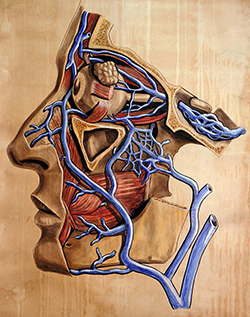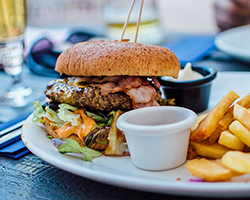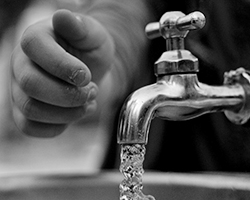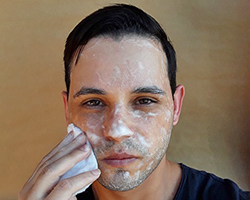
Illustrated by: Claire Murphy

If you want to know how healthy you are, you might visit the doctor for a blood test. But what do you do if you want to know how healthy your neighborhood is? Or how healthy your city is? The best source of information may be right under your home or your street.
There, you may find a series of pipes crisscrossing your neighborhood and city. Sliding and flowing through the sewers is everything you flush down a city toilet. Like the veins in your body, the veins of the sewer contain a lot of information about the people in an area. It is that smelly source that gives researchers like Rolf Halden clues about the health of a community.
For over 15 years, Halden has been using wastewater that runs through our sewers as an information source. Halden gathers information on what people eat, what toxins are present, and what medications and drugs people use. Then he determines how these things affect the health of a community.
City Disease Tracking
Information about certain diseases we are susceptible to can be found in our DNA. For example, people can have a genetic predisposition for diseases like Alzheimer’s. But it is not just DNA that determines if a person will get sick and what will cause their illness; the environment plays a role too.

What a person is eating, doing, and being exposed to can trigger a disease that they might be more likely to have. In his research, Halden looks for those disease triggers and how they impact a neighborhood of people. Then he works to figure out how we can use that knowledge to stop people from being exposed so they can avoid developing those diseases.
Halden and his research group are working with the city of Tempe, Arizona in the USA on two very important projects. They are looking at wastewater in Tempe to track viruses and to prevent diseases, from COVID-19 to the common flu. They are also tracking the use of everyday chemicals, like medicines and drugs. They are doing this to better understand how and why people are using them, and how to help them to not use drugs and get better. If the city knows where people are using drugs, they know where clinics are most needed for drug users to get help.
Tracking Toxins and Human Health in Sewers
The sewers don’t just contain our body waste and the medications we take. They also contain toxins that we put down our drains. Heavy metals, like mercury and the flame retardants that are used in some toys and other products, are an example of these toxins.

Halden researches how chemicals get into our wastewater systems. He looks at the types and the amount of toxins. Then he tracks these to see where they are coming from. These toxins can end up in recycled wastewater, which can be used to water grass, flush toilets, fill manmade lakes, and more. If the toxins aren't removed before this, they can seep into the groundwater, and groundwater is used for us to drink. This is a big problem because toxins in our drinking water can make us sick.
Halden uses this information to help make technologies that can remove the toxins from our systems. Sometimes this means the U.S. Food and Drug Administration takes a chemical out of circulation nationwide with the help of data produced by Halden’s research team.
Teeny Tiny Plastic
You wake up in the morning, brush your teeth, then wash your face. As you scrub your face, you may feel little plastic beads against your skin that get formulated into some personal care products. More tiny plastic particles may be present in your salt, drinking water, and the food you consume. Today, plastics are everywhere and their impact on human health is still not well understood.

To learn more about whether these chemicals make it into our bodies, Halden and his team are looking at wastewater for signs that people have had plastic go through their bodies. His team can even determine if plastic components have traveled through the human body. They do this by looking at slight changes in the chemical’s structure that reveal past exposure of humans.
We use so much plastic in our every-day lives, and that plastic breaks down, but never really goes away. People put a lot of plastic down drains, from laundry that releases plastic fibers to disposable contact lenses. Over time small plastics break down into smaller and smaller pieces—these are called microplastics. If they become even smaller, to where they can’t be seen with normal microscopes, they are called nanoplastics.
From what people put into drains, to what is in landfills, a lot of microplastics wash into rivers and waterways and then end up in tap water and bottled water. In these ways the plastic comes back and can do harm to us. One thing we all can do is to use fewer plastics to reduce the source of these microplastics that are around and within us.
Secrets in Sewers was created in collaboration with The Biodesign Institute at ASU.
Water splash image by Dirk Wohlrabe via Pixabay.
Read more about: Secrets in Sewers
Bibliographic details:
- Article: Secrets in Sewers
- Author(s): Challie Facemire
- Publisher: Arizona State University School of Life Sciences Ask A Biologist
- Site name: ASU - Ask A Biologist
- Date published: 25 Jan, 2022
- Date accessed: 19 May, 2025
- Link: https://askabiologist.asu.edu/explore/secrets-sewers
APA Style
Challie Facemire. (Tue, 01/25/2022 - 21:33). Secrets in Sewers. ASU - Ask A Biologist. Retrieved from https://askabiologist.asu.edu/explore/secrets-sewers
Chicago Manual of Style
Challie Facemire. "Secrets in Sewers". ASU - Ask A Biologist. 25 Jan 2022. https://askabiologist.asu.edu/explore/secrets-sewers
MLA 2017 Style
Challie Facemire. "Secrets in Sewers". ASU - Ask A Biologist. 25 Jan 2022. ASU - Ask A Biologist, Web. https://askabiologist.asu.edu/explore/secrets-sewers

Be Part of
Ask A Biologist
By volunteering, or simply sending us feedback on the site. Scientists, teachers, writers, illustrators, and translators are all important to the program. If you are interested in helping with the website we have a Volunteers page to get the process started.


